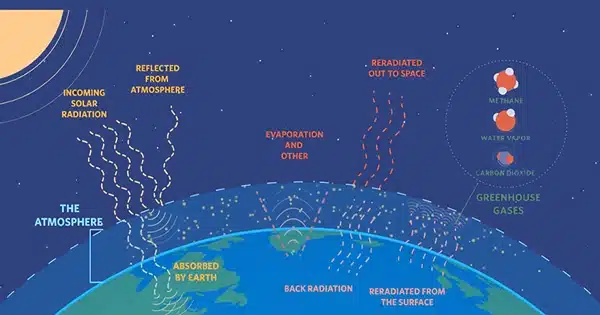According to a recent World Meteorological Organization analysis on the health of the climate, the global mean temperature in 2022 will be 1.15°C higher than the 1850-1900 (preindustrial reference period) average. Furthermore, the previous eight years have been the warmest since instrumental temperature records began 173 years ago.
To put it another way, the climate system has been out of balance for decades.
As a specialist in atmospheric science, my goal is to shed light on the Earth’s energy imbalance and its implications for humanity.
Earth’s energy imbalance: Other energy sources, such as Earth’s internal heat and tidal energy, are insignificant in comparison to solar radiation. The Earth reflects around 30% of solar radiation and emits radiation into space.
Greenhouse gases (carbon dioxide and methane) allow solar radiation to pass through but not radiation generated by the Earth, trapping this energy. Without the greenhouse effect, the Earth’s near-surface temperature, which is 15°C, would be roughly -19°C.

The difference between incoming energy – solar radiation – and outgoing energy – the sum of solar radiation reflected by the Earth and radiation emitted by the Earth – is referred to as Earth Energy Imbalance (EEI) if it is greater than zero.
Human activity has caused the Earth’s energy imbalance by emitting greenhouse gases (creating an additional greenhouse effect).
But where does the surplus energy go? It accumulates as heat in the many components of the climate system (atmosphere, land, hydrosphere, cryosphere, and biosphere). And this is why the Earth is warming, or, more broadly, climate change.
The ocean acts as a heat sink: To better understand the influence of Earth’s energy imbalance on the climate system, an international effort to assess the Earth’s heat inventory is required.
A newly released study presented such an inventory for the time period 1960-2020. According to this study, the Earth’s system has been storing heat since 1971. Furthermore, the rate of heat accumulation from 2006 to 2020 is larger than the rate from 1971 to 2020. The ocean stores the majority of the extra heat (89%), primarily in the upper ocean (0-700 meters depth). The remaining extra heat is held in the land (6%), and the atmosphere (1%), and has resulted in the melting of cryosphere components such as glaciers, ice sheets, and sea ice (4%).
In addition to storing excess heat, the ocean is a significant CO2 sink, playing an important role in climate management. The ocean, on the other hand, will grow less efficient at collecting CO2 as CO2 emissions increase. Why? Because of the positive feedback between ocean warming and a decrease in ocean capacity to absorb CO2.
Unfortunately, the ocean’s current situation is alarming. The ocean heat content hit a record high in 2022, with at least one marine heatwave affecting 58% of the entire surface. The mean ocean surface temperature has been the highest since the beginning of the satellite era since mid-March of this year. Marine heatwaves, among other harmful effects on marine ecosystems, induce coral bleaching episodes.
The ramifications of the imbalance: As the recently published Synthesis Report of the Intergovernmental Panel on Climate Change (IPCC) reminds us, global warming has detrimental consequences for humans and ecosystems. According to the analysis, between 3.3 and 3.6 billion people now reside in areas that are extremely vulnerable to global warming.
People who live along the coast are particularly vulnerable. The risk of coastal flooding increases when sea levels rise, which is caused mostly by thermal expansion of the ocean and melting of glaciers and Antarctic and Greenland ice sheets. To provide some numbers, the contributions of ocean thermal expansion and land ice melting to sea level rise were 55% and 36%, respectively, from 2005 to 2019.
Global warming endangers not just our physical health, but also our mental health. In effect, unexpected catastrophes (such as hurricanes and storms) can produce trauma. Changes in climate variables (for example, drought) might create uncertainty. Climate anxiety can result from increased awareness of climate change.
This demonstrates how the imbalance of the climate system might result in our own imbalance.
Given the scientific community’s frequent warnings concerning the adverse effects of climate change on our communities, we may wonder: Could global warming lead to the breakdown of society on a worldwide scale, or perhaps the extinction of human beings?
Unfortunately, this topic has not gotten the attention it deserves. Luke Kemp, a researcher at the University of Cambridge’s Centre for the Study of Existential Risk, and his colleagues have proposed a study program dubbed “Climate Endgame.”
Net zero emission is a win-win situation: As long as there is an energy imbalance, the Earth will continue to warm. Because human-caused emissions are to blame for the Earth’s energy imbalance, the remedy is, in theory, straightforward: emissions must be lowered to zero.
What can we do on a personal level? We may limit our contribution to climate change by walking and biking, eating less meat and dairy products, decreasing food waste, and improving the energy efficiency of our homes, among other things.
As a result, the climate game is far from done. We must determine whether or not to address the climate crisis.
















